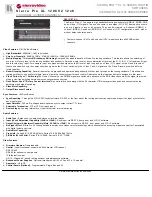
TCCS Plus
copyright © 2021 Operative Experience
10001_B
4
All rights reserved
Understanding Your Simulator
Each of the six (6) configurations of the military grade, high-fidelity TCCS Plus simulators has specific features
and wounds designed for prolonged field care training and comprehensive all-compatant TCCC training.
Common Features
Though each simulator has unique attributes, all have the following common features:
Airways
Endotracheal tube placement
Tongue-swelling for difficult airway
Bag-valve-mask ventilation
Assessment of oral and nasal areas
Insert nasal and oral pharyngeal airways
Perform intubation – King LT and i-gel
Cricothyrotomy
Circulation
Remote-controlled heart rate
Humeral and sternal intraosseous
ECG
Blood pressure measurement
Carotid, brachial, radial, femoral, popliteal, posterior tibial, and dorsalis pedis pulses
Defibrillation, cardioversion and pacing (with iSimulate monitoring software)
Hemorrhage Management
Remote-controlled pulsative arterial hemorrhage
Remote-controlled venous bleeding
Bleeding control via pressure, elevation, and pressure points
Combat Application Tourniquets, and junctional tourniquets
Wound packing
Multiple and independent bleeding sites
Penetrating trauma wounds
Breathing
Remote-controlled respiratory rate
Bilateral and independent chest excursion
Tension pneumothorax corrected by midclavicular and anterior axillary
Support to external ventilation
Bilateral chest tube insertion
Sounds
Airway sounds [
No Sound, Healthy (Normal), and Stridor]
Heart sounds
(Normal S3, S4, S3 & S4, Early Systolic Murmur, Mid Systolic Murmur, Late Systolic
Murmur, Pan Systolic Murmur, and Late Diastolic Murmur)
Lung sounds [
No Sound, Healthy (Normal), Wheeze, Rhonchi, Pleural Rub, and Crackles]
Medication and Vascular Access
Intramuscular sites for medication
IV cannulation (via the IV sleeve)













































